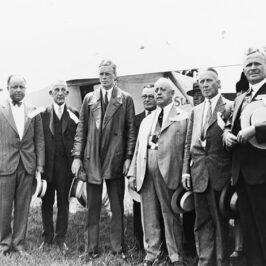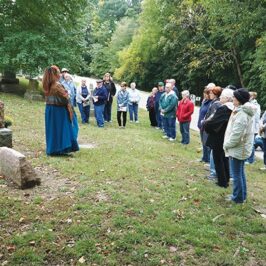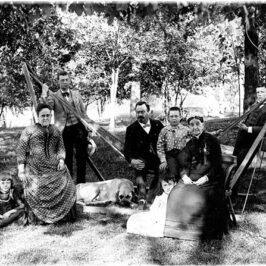
By Cinda Ackerman Klickna
The truth is rarely pretty or polite. When Colonial Williamsburg historians decided several years ago to add a portrayal of the real story of slaves at Williamsburg, visitors found the reenactments disturbing. Others claimed it was finally time to embrace the truth.
So, too, can we here in Illinois, admit, acknowledge, and accept the truth: Illinois, at least in five southern counties (St. Clair, Gallatin, Randolph, Edwards and Pope), did indeed embrace slavery as an institution. The supporting documents to this long-known but little acknowledged chapter in Prairie State history have been brought to light by the Illinois State Archives through its index to Illinois Servitude and Emancipation Records from 1722-1863.
There is really no mistaking what these handwritten records really are: grants of emancipation; actual bills of sale; lists of slaves being auctioned; even lists ol slaves as gifts through wills, deeds, or estate settlements. Over 2,000 names of Native and African Americans are included in the Servitude and Emancipation Index. The records provide a fascinating and disturbing glimpse into early Illinois history.
Charles Cali (now retired), Barbara Hellin, and Karl Moore of the Illinois State Archives oversaw the development of the Servitude index in print form as well as a web site in an abbreviated version. The original research began in 1990 by David Richards, then an intern with the Archives, who used available documents to index known African Americans and Indians living in Illinois. Although other counties more than likely had similar servitude, Richards’ research focused on Randolph and St. Clair counties. The Archives subsequently indexed Gallatin, Pope, and Edwards counties. Information from other counties remains buried in deeds, wills, and estate documents.
The web site lists the slave owner’s name, county, slave’s name, age and race, the type of document listing the information (will, deed, etc.), and its date. The print index, housed at the Archives, includes more detail, such as pertinent notes copied from the original documents.
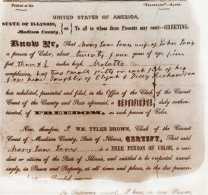
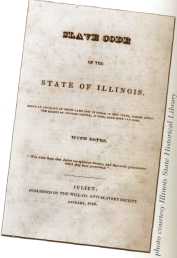
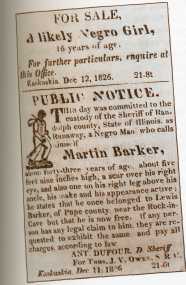
The French period
Many records date from the early French colonial period (1722-1790) and the American Period (1790-1863). The French owned slaves, both Indian and Negro (the language used in the original documents and, for consistency, used in the listings).
According to Archivist Karl Moore, the French prized their slaves, considered them bien-foncier (valuable property), and registered them as such.
A problem arose in 1787 when the French wanted to keep their slaves at the time Illinois became part of the Northwest Territory, which forbade slavery. The French influence led to the extension of slavery beyond the 1790s.
Illinoisans knew but overlooked slavery — even until the 1860s. After statehood in 1818, the General Assembly instituted “Black Codes,” which allowed indentured servitude (service to another for from one to ninety-nine years). The black codes also denied legal protection to Negroes and required them to register with local governments. Blacks in Illinois were required to file a certificate of emancipation within their home county to prove the status of “free Negroes.” Black laws limited the rights of blacks and, in essence, established pseudo slavery in Illinois.
The earliest records in the state’s Servitude and Emancipation Index date from 1722. Some servants’ names are blank; some only have a first name listed indicating either an unknown last name or no last name; some have full names listed, often that of their owner. Physical descriptions often accompany the mention of an Indian or Negro: “crooked left middle finger,” “scar on left temple,” “5′ 3,” “scar on left foot from axe wound.” The French treated their slaves as items that could be bartered, traded, and sold. In 1773, Jacque LaCourse sold a “parcel of land in the prairie of Kaskaskia for a Negro boy, age 12 or 13” (no name given). Another Frenchman, Jean Huberdeau, sold a house and two lots in Kaskaskia to Antoine Bienvenu for a “mulatto girl 17-18 years old.” In 1725, Onesime Fortunay sold a four-year-old male Negro child for “600,
10 x 1 walnut planks 10 feet long.”
The French occasionally mortgaged slaves, leased their services at public auctions, gave slaves as gifts, or used slaves as settlements in estates. One slave was listed as “collateral for a loan” in 1793. Another notes that a “7-year-old Negro girl valued at 300 livres” (pounds) was given as a wedding gift to Paul Reame and Marie Louise Lasonde on January 30, 1743.” An estate settlement of 1739 records this transaction: “To Catherine is given a Negro boy named Ignace.”
From reading these documents it is clear French settlers in Illinois were very matter-of-fact about the sale and disbursement of their human property.
“Sold for 1500 livres in ‘flour, hams or money, Chocolas, a male Negro– 1740.”
“Female Indian slave sold for 800 livres in ‘notes or flour’–1740”
“Gift of 2 Indian slaves to my minor children, Marie and Pierre–from Marie Rose Terier in St. Clair County on December 20, 1830.” A Christmas present, perhaps?
These sales were not limited to the local area. In one instance, money for an Illinois slave sale ended up halfway round the world: “Sale of male Negro slave named Mouca, a negress named Marie and their children, a boy, Joseph, and 2 girls, Marie and Ursulc…for 4500 livres, of which Vivareine (Jean Batiste Vivareine) has been paid 2900 livres. The remainder is owed to the Royal Indies Company.”
The Index includes 56 Indian slaveowners, and not only do the notations provide information about the Indian leaders but also insight into the relationship between several Indian tribes and the French. A dated trade agreement of June 28, 1745, between Alarie J. Baptiste and Guillaume La Doucier clarifies that “traders agree to abide by various rules, including they will buy no Nakitoches or Chonis (Shawnee) slaves.”
One record provides information about the Fox nation and its chief. A court document from the future St. Clair County dated June 8, 1765, state: “Marie, a free Fox Indian woman, formerly serving Chauvin. She was taken prisoner by the French during their war with the Fox. Due to ill treatment, she chose to leave Chauvin, who then illegally traded her to Trudeau for 2 young Indian slaves. Court has seen the written testimony of May 16, 1765, by the great chief of the Fox nation, that his niece is a free woman, and also the testimony of the great chief Mequac. Court wishes to avoid a war with the Fox nation and finds for the plaintiff, who is declared to be free… Chauvin is ordered to return the 2 slaves he took in exchange for her.”
Other listings offer insight into another tribe, the Chickasaws (sometimes spelled “Chicacha”). The deposition of Pierre Chabot dated November 11,1740, concerns a “female Chicacha slave who formerly belonged to the late Charles Neau… [Said] slave was returned to the Chicachas who came to find her… with a promise of reimbursement to Neau.” In a July 2, 1770 petition regarding a fugitive slave, we learn of the Chickasaws. “Fagot La Garciniere has learned from some recently arrived Chickasaws that a mulatto he sent 2 years ago to Blouin to be sold, had escaped to the Chickasaw village with an Indian of Blouin’s last December, and is now in the hands of English traders there. Viviat will repay the traders, collect the slaves for Fagot, and distribute gifts to the Indians.”
These records provide a key to understanding people, places, occupations, and terminology. A bill of sale from April 25, 1748, identifies the parties and their “sale of a female Indian slave, about 30 years old, by Marie Fafard, wife of Louis Netivier of Fort de Chartres, to Pierre Messager, trader in Illinois, for 400 livres in 100 livres of powder and 50 ecus (coins) of cloth, at port prices.”
The American period
The Archives slave registry also contains 649 items documenting emancipations. On February 7, 1827, Martha Praten of Gallatin County freed twenty-two slaves, ages one to twenty-eight, some bearing no last name, others with Praten’s surname. Her handwritten statement, reads: “I, Martha Praten of Gallatin, in order to carry into effect the will of my late husband.. .and to effect my own will… do freely and voluntarily emancipate, set at large, and restore to their natural liberty the following named Negro slaves of mine which I have raised myself and brought out to this state for the purpose aforesaid.” Included are such names as Hercules, Ailsy, Lucy, Anna, and Elsy-Anne.
A year later, on July 21, 1828, John McCallister emancipated 61 slaves, ranging in age from 1 to 80. Ponso, a forty-five-year-old slave; his wife, Jenny; and their nine children were all freed, and Ponso was given all of McCallister’s carpenter tools upon the latter’s death.
Although emancipations were occurring, Illinoisans continued to indenture their “servants.” Throughout both the French and American periods, Indians and blacks willingly indentured themselves. On December 17, 1810, George, a twenty-year-old Negro, became an indentured servant to David Black in Pope County for 60 years– until December 17, 1870. The record, however, doesn’t indicate an indenture or willingness on the part of George to serve. The record shows the parties knew they were entering a business transaction, as David Black “purchased George from Thomas Dunlanson of Christian County in Kentucky for $400.” One can only wonder what happened to George after his servitude was outlawed in Illinois before his “service” expired.
In some indenturing, the servant was paid for agreeing to be indentured. In 1794, George, a free Negro, agreed to serve William Musick for seven years for $200. An 1808 record notes that a woman named Phebe “obligates herself to serve William Morrison for 4 years in return for 10 cents.” Obviously, some cases included participants who were already free but compelled by the need for money to sign indentures.
Some slaves paid to obtain their freedom. An emancipation document executed on June 19, 1828 between William Davis and his slave, David Davis, states: “for the payment of $100 paid every June 19 until 1831, William Davis will set free and emancipate David as soon as the payments are made, $300 total.”
While some were eager to emancipate, others, including influential leaders of the state, chose to continue as slave owners. Four Illinois governors owned slaves: Shadrach Bond, the first Illinois governor (1818-1822) had two women indentured to him in 1807, Hannah and Prudence Hansberry, both aged 16. According to the 1820 census, Bond owned 14 slaves. When he died in 1832, he bequeathed 9 slaves to his wife and daughters.
Illinois’ second governor, Edward Coles (1822-1826), inherited 20 slaves from his father prior to living in Illinois. To the shock of family, Coles freed his slaves, came West, and eventually bought 6,000 acres near Edwardsville, hiring some of his freed slaves to work his farm. In Coles’ inaugural address, he asked for the abolishment of the indenture system and black codes; called for the kidnapping of freed blacks to stop; and supported emancipation for descendants of slaves brought to Illinois during the French period. His speech openly accused lllinoisans of practicing a system of slavery that many refused to admit. Two years later, the Illinois legislature had an anti-slavery majority, but little changed.
Illinois’ third governor, Ninian Edwards (1826-1830), bought and sold indentured servants, rented them out for forced labor, and did not free his slaves, who worked on his Kentucky plantation. In fact, in an 1832 register of Blacks, Edwards lists his slave, Charles, as “my property.”
Illinois’ fourth governor, John Reynolds (1830-1834), owned seven slaves and emancipated them over a period of 20 years.
The last emancipation documented in the Archives’ Illinois Servitude Index did not occur until 1863, when Marva Reed was legally freed from Aaron Shook in St. Clair County. That same year the Illinois legislature proposed a resolution objecting to Lincoln’s Emancipation Proclamation, but then-Governor Richard Yates dismissed the General Assembly before such resolutions could be enacted. It wasn’t until 1865 that Illinois and the rest of the country ratified the Thirteenth Amendment, which outlawed slavery in the nation.
The Servitude and Emancipation Index opens a window on early Illinois social mores as well. Slave Marie Jeanne was accused of murdering her child on July 15, 1748. The court record reports:
“denunciation…by Jerome Matis, of a Negro slave leased to him by Mme. Lasource, acting as guardian of Marie Vincennes. The slave was pregnant when she was leased to him; on July 3, he noticed she seemed near to delivery, but she denied being pregnant. On July 4, she gave birth to a soft mass of flesh, but not to a child, in the presence of Mme. Beauvais, at the house of Joseph Braseau, where Matis lives. On the following Sunday, July 7, M. and Mme. Braseau found the arm and parts of the skull of a child at their doorstep, and upon searching the premises, found a grave and several other pieces of the body in the pig sty and the barn. Matis accuses the slave of murdering her child. Jeanne ‘denies having murdered her infant and also denies any knowledge of having born a living child.'”
Jeanne was eventually imprisoned in Kaskaskia until the next convoy would ship her down to New Orleans to stand before the “Superior Council.” Another slave, Catherine, witnessed the attempted suicide of her owner, Jacque Felix Teodore Carton, on August 2, 1786. Neighbors, upon hearing a shot in Carton’s house, “opened a window there and observed him on the floor near his bed in a cloud of gun smoke, 2 pistols by his side, 1 recently fired. Carton’s left side showed a powder burn and a bullet hole. Catherine, his Negro slave, was in a corner of the room at the time and went to the parish priest… who found Carton still breathing.”
Poor treatment of slaves occurred in both the French and American periods. Judge Delaoere Flaucour passed judgment against a slaveowner on May 7, 1743, for “Interrogation and flogging of several Negro and Indian slaves accused of plotting to desert and stealing a pirogue.” Judge Flaucour, convicted the slaves of desertion, but suspended their sentence on the pleas of the master, who promised to watch his slaves more carefully. The judge also ordered that “the Slave Code be read aloud for 3 Sundays, to prevent the plea of ignorance in such cases.”
Another slave, John Baxe, who assaulted his owner, Francois Bastien, received the following sentence: “To make public apology upon his knees to Bastien, whom he assaulted… the death penalty is not invoked, but [Baxe] shall be beaten on three different days…,”
While one court entry shows the granting of emancipation, another on the same date records the auction of a slave family.
The truth about Illinois’ slave past has taken nearly three centuries to surface. And while the stories behind the documents might be lost forever, the old court records are fascinating and pose many unanswerable questions. What happened to these marginalized people? How did their lives in post Civil-War Illinois play out? Are their descendants still among us today, or did they move West seeking an illusive freedom on the frontier? The answers to these and other questions await the eager researcher at the Illinois State Archives.
Freelance writer Cinda Klickna of Rochester is president of the Springfield Education Association.
For further reading see:
The History of Negro Servitude in Illinois and of the Slavery Agitation in the State, 1719-1864, by Dwight D. Harris (1904), reprinted 1968.
| Edward Coles and the slavery issue One of the most important issues in Illinois history was whether the newly formed state should legalize slavery. As part of the Northwest Territory, Illinois was allowed to become a state in 1818 only if it adopted a constitution that banned slavery. However, when Missouri was admitted to the Union as a slave state in 1820, hundreds of immigrants from the South passed through Illinois and settled west of the Mississippi. Many citizens of Illinois felt that future growth and economic prosperity would elude their state unless the constitution was changed. This change might have been afiected had it not been for the beliefs and efforts of Illinois’s second governor, Edward Coles. Coles was born into an aristocratic, slaveholding family in Virginia on December 15,1786. While attending William and Mary College, he became convinced that slavery was immoral and could not be reconciled with Thomas Jefferson’s doctrine that all men are created equal. While serving as private secretary for President James Madison, Coles determined he must sell his plantation and remove his slaves to the West. In April 1819, Coles and a slave named Ralph Crawford organized and directed the exodus from Virginia. While aboard keelboats on the Ohio River, Coles told his slaves they were now free. They could leave or go with him to Illinois, where he promised each family 160 acres of land as a gift for their service. In Illinois, Coles was the Register of the Federal Land Office at Edwardsville and quickly won the respect and friendship of the people he served. In October 1821, Coles “took to the stump” and campaigned to become the second governor of Illinois. Three pro-slavery candidates also ran, which split the electorate and gave Coles a 167-vote margin of victory. For a free state, Illinois had a long tradition of slavery. The first black slaves were brought to the American Bottom area by the French in 1719. Some descendants of those first slaves were still in servitude at the time of statehood in 1818. Between 1810 and 1820, Illinois was the only Northern state to show an increase in its slave population. On December 5, 1822, Governor Coles addressed the Illinois General Assembly and asked them to pass laws that would protect free blacks and not allow slavery in any form. The pro-slavery General Assembly did just the opposite. First the Assembly purged its ranks of a Pike County representative who supported Coles, then it seated his opponent. Later the General Assembly voted to go to the electorate with a referendum calling for a Constitutional Convention. They intended for this new constitution to make Illinois a full-fledged slave state. Future Governor John Reynolds later reflected, “The Convention question gave rise to two years of the most furious and boisterous excitement that ever visited Illinois.” According to Illinois historian Thomas Ford (Illinois’ 8th governor), in the eighteen months between passage of the bill and the 1824 election, “The whole people did scarcely anything but read newspapers, handbills and pamphlets, quarrel, wrangle and argue with each other whenever they met together to hear the violent harangues of their orators.” In Edwardsville, a state senator physically attacked an anti-slavery newspaper editor while daggers and pistols were drawn. Governor Coles entered the fray by leading the anti-slavery convention men against almost all of the state’s established political leadership. Coles donated his $1,000 salary to the cause each year and sought intellectual help from Quakers in Philadelphia. Most influential in helping Coles were: The Reverend John Peck and most of the Baptist and Methodist clergy; Morris Birbeck and the English immigrants of Edwards County; and Congressman Daniel P. Cook. Gaining ownership of the bankrupt Illinois Intelligencer newspaper a few months before the election, Coles changed its editorial stance from pro-slavery to anti-slavery. When the vote to convene a Constitutional Convention took place on August 2, 1824, 6,640 of the 11,612 white males voted against the Convention and to thereby to slavery in Illinois as well. It has been said that Governor Coles was a victim of his own integrity. After the election he lost all political power. His appointments went unconfirmed by the legislature and he never again was elected to public office. After suffering the indignity of being sued for bringing his slaves into Illinois, and the destruction of much of his estate by fire, Coles moved to Philadelphia in 1832. He died on July 7, 1868, at the age of 81. Many believe Governor Coles was chiefly responsible for preventing Illinois from becoming a slave state. This was important in attracting anti-slave settlers such as Thomas Lincoln and his son, Abraham, to Illinois. Mark W Sorensen |




